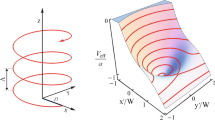Abstract
The modal properties of curved dielectric slab waveguides are investigated. We consider quasi-confined, attenuated modes that propagate at oblique angles with respect to the axis through the center of curvature. Our analytical model describes the transition from scalar 2-D TE/TM bend modes to lossless spiral waves at near-axis propagation angles, with a continuum of vectorial attenuated spiral modes in between. Modal solutions are characterized in terms of directional wavenumbers and attenuation constants. Examples for vectorial mode profiles illustrate the effects of oblique wave propagation along the curved slab segments. For the regime of lossless spiral waves, the relation with the guided modes of corresponding dielectric tubes is demonstrated.















Similar content being viewed by others
Notes
Other scenarios, like the evanescent excitation through a slab, with potentially different layering, placed “underneath” the bend at a small distance, would lead to a different rule of translating \(k_y\) to an angle of incidence.
Note that the definition of \(k_\theta\) depends on the—arbitrary—definition of the bend radius R (Hiremath et al. 2005).
Note that it depends on the (arbitrary) definition of the bend radius, whether, for large R, the curve \({\mathfrak {R}}\,k_\theta /k_0\) approaches the level \(N_{\mathrm{eff}}\) from above, or from below (Hiremath et al. 2005).
References
Abramowitz, M., Stegun, I.A.: Handbook of Mathematical Functions. National Bureau of Standards, Washington, DC (1964)
Birks, T.A., Knight, J.C., Dimmick, T.E.: High-resolution measurement of the fiber diameter variations using whispering gallery modes and no optical alignment. IEEE Photon. Technol. Lett. 12(2), 182–183 (2000)
Chin, M.K., Chu, D.Y., Ho, S.-T.: Estimation of the spontaneous emission factor for microdisk lasers via the approximation of whispering gallery modes. J. Appl. Phys. 75(7), 3302–3307 (1994)
Hammer, M.: Oblique incidence of semi-guided waves on rectangular slab waveguide discontinuities: a vectorial QUEP solver. Opt. Commun. 338, 447–456 (2015)
Hammer, M.: OMS—1-D mode solver for dielectric multilayer slab waveguides (2016). http://www.computational-photonics.eu/oms.html
Hammer, M., Hildebrandt, A., Förstner, J.: How planar optical waves can be made to climb dielectric steps. Opt. Lett. 40(16), 3711–3714 (2015)
Hammer, M., Hildebrandt, A., Förstner, J.: Full resonant transmission of semi-guided planar waves through slab waveguide steps at oblique incidence. J. Lightwave Technol. 34(3), 997–1005 (2016)
Hiremath, K.R., Hammer, M., Stoffer, R., Prkna, L., Čtyroký, J.: Analytical approach to dielectric optical bent slab waveguides. Opt. Quantum Electron. 37(1–3), 37–61 (2005)
Jackson, J.D.: Classical Electrodynamics, 3rd edn. Wiley, New York (1998)
Lock, J.A.: Morphology-dependent resonances of an infinitely long circular cylinder illuminated by a diagonally incident plane wave or a focused gaussian beam. J. Opt. Soc. Am. A 14(3), 653–661 (1997)
Maple 2016 technical computing software. https://www.maplesoft.com/products/maple/
Okamoto, K.: Fundamentals of Optical Waveguides. Academic Press, SanDiego (2000)
Poon, A.W., Chang, R.K., Lock, J.A.: Spiral morphology-dependent resonances in an optical fiber: effects of fiber tilt and focused Gaussian beam illumination. Opt. Lett. 23(14), 1105–1107 (1998)
Press, W.H., Teukolsky, S.A., Vetterling, W.T., Flannery, B.P.: Numerical Recipes in C, 2nd edn. Cambridge University Press, Cambridge (1992)
Schwefel, H.G.L., Stone, A.D., Tureci, H.E.: Polarization properties and dispersion relations for spiral resonances of a dielectric rod. J. Opt. Soc. Am. B 22(11), 2295–2307 (2005)
Snyder, A.W., Love, J.D.: Optical Waveguide Theory. Chapman and Hall, London (1983)
Tien, P.K.: Integrated optics and new wave phenomena in optical waveguides. Rev. Mod. Phys. 49(2), 361–419 (1977)
Ulrich, R., Martin, R.J.: Geometrical optics in thin film light guides. Appl. Opt. 10(9), 2077–2085 (1971)
Vassallo, C.: Optical Waveguide Concepts. Elsevier, Amsterdam (1991)
Acknowledgements
Financial support from the German Research Foundation (Deutsche Forschungsgemeinschaft DFG, Projects HA 7314/1-1, GRK 1464, and TRR 142) is gratefully acknowledged.
Author information
Authors and Affiliations
Corresponding author
Appendix: Continuity of spiral mode profiles
Appendix: Continuity of spiral mode profiles
We refer to the bend configuration as introduced in Fig. 1, and the formalism of Sects. 2.1–2.1.2. Principal field components \(E_y\) and \(H_y\) are defined piecewise for the regions \(r<R-d\), \(R-d< r< R\), and \(R< r\) in the form of Eq. (8), with separate coefficients \(A_E\), \(B_E\), \(C_E\), \(D_E\), and \(A_H\), \(B_H\), \(C_H\), \(D_H\), respectively. Equations. (5) relate the principal fields to the remaining electromagnetic components \(E_\theta\), \(H_\theta\), \(E_r\), and \(H_r\).
Requiring the principal components \(E_y\) and \(H_y\), and the angular components \(E_\theta\) and \(H_\theta\), to be continuous at \(r= R^- = R-d\) leads to the equations
Likewise, these four fields are continuous at the outer interface at \(r=R\), if the equations
are satisfied. Here abbreviations \(\chi _r=\sqrt{k_0^2n_r^2-k_y^2}\), for \(r \in \{{\mathrm {s}},{\mathrm {f}},{\mathrm {c}}\}\), have been introduced. Signs ± and \({\mp }\) distinguish wavenumber parameters \(k_y\,\lessgtr\,k_0n_{\mathrm{c}}\). Just as in the discussion of Eq. (8), the √-symbol is meant to indicate the positive real root, for a positive radicand, or the imaginary root with positive imaginary part, in case of a negative radicand. Eqs. (14)–(21) imply continuity of \(H_r\) and of \(n^2 E_r\) at the radial positions of both interfaces.
Rights and permissions
About this article
Cite this article
Ebers, L., Hammer, M. & Förstner, J. Spiral modes supported by circular dielectric tubes and tube segments. Opt Quant Electron 49, 176 (2017). https://doi.org/10.1007/s11082-017-1011-x
Received:
Accepted:
Published:
DOI: https://doi.org/10.1007/s11082-017-1011-x




